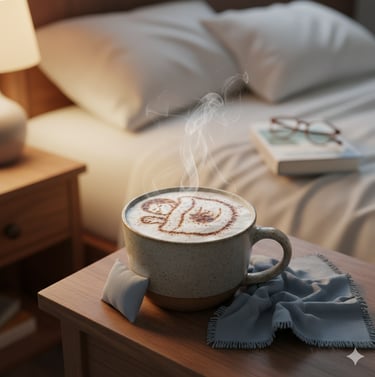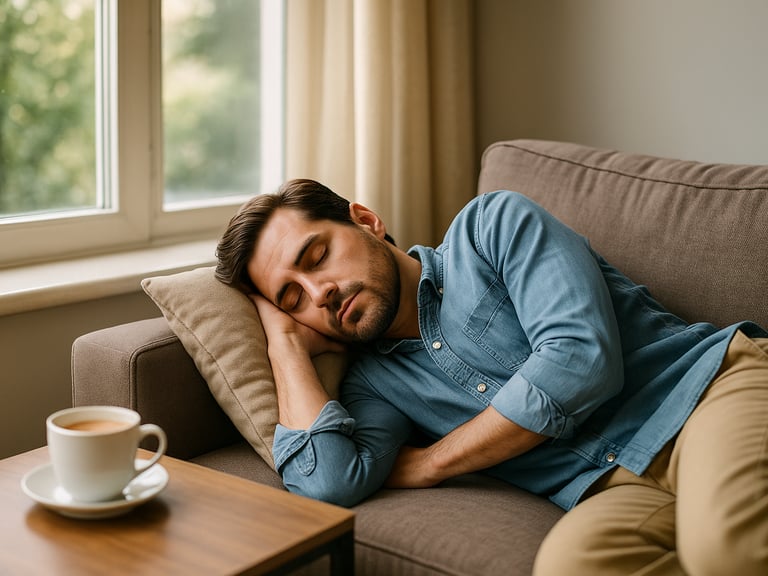"I Survived. I Lived. Then I Woke Up."
Discover the Power of the Nappuccino (2025 Guide)
Learn the best and worst times to nap according to sleep experts and discover what a “nappuccino” is — the coffee-nap combo that boosts energy and focus instantly.
MENTAL HEALTH INSIGHTSHEALTH & WELLNESS
Christopher J
10/27/20252 min read


Understanding the Science of Napping
Our bodies are wired for rest, not just at night but also during the day. Napping isn’t a sign of laziness—it’s a natural response to our circadian rhythms and homeostatic sleep pressure. Around midday, usually between 1 p.m. and 3 p.m., the body experiences a dip in alertness, making this the perfect time to recharge with a nap.
Why Our Bodies Naturally Want to Nap
Our energy levels fluctuate throughout the day. After lunch, blood sugar rises slightly, and our internal clock sends signals to rest. This “afternoon slump” is universal, which explains why cultures like Spain and Italy traditionally embrace siestas.
The Role of Circadian Rhythms and Sleep Pressure
Sleep pressure builds the longer we’re awake. Napping helps release some of that pressure without resetting the clock entirely. However, timing matters — nap too late, and your body may struggle to fall asleep at night.
The Best Times to Nap: What Sleep Experts Recommend
The Ideal Afternoon Power Nap (1 p.m.–3 p.m.)
According to sleep researchers, the sweet spot for napping is between 1 p.m. and 3 p.m. This period aligns with your body’s natural dip in energy. Napping at this time enhances alertness, memory, and mood without interfering with nighttime sleep.
Short Naps vs. Long Naps: Which Is Better for You?
A 20-minute nap is perfect for a quick mental reset — it keeps you in lighter sleep stages, so you wake up refreshed. Longer naps (60–90 minutes) allow for a full sleep cycle, which can improve creativity but may leave you groggy.
What Exactly Is a “Nappuccino”?
The “nappuccino” combines two powerful fatigue fighters — a nap and coffee. It involves drinking a small cup of coffee right before a 20-minute nap. By the time you wake up, caffeine kicks in, amplifying your energy levels.
How the Nappuccino Works: Science Behind It
Caffeine takes roughly 20 minutes to absorb into your bloodstream. When you nap right after drinking it, adenosine (the compound that makes you tired) decreases, and caffeine binds more effectively to your brain’s receptors — creating a double alertness effect.
Step-by-Step Guide: How to Take the Perfect Nappuccino
Drink a small cup of coffee or espresso.
Set an alarm for 20 minutes.
Find a quiet, dark space to relax.
Close your eyes immediately and rest — don’t overthink falling asleep.
Wake up as your caffeine kicks in, refreshed and focused.
Boosts alertness and short-term memory
Lowers stress levels and improves emotional control
Improves learning and information retention
Reduces fatigue, especially for shift workers and parents
Studies published in Sleep Health Journal show that regular short naps lower the risk of cardiovascular disease and improve overall cognitive performance.
Conclusion: Nap Smarter, Not Harder
Napping is a science-backed secret weapon for better focus, health, and mood — but only when done at the right time. Aim for a short, early afternoon nap and experiment with the nappuccino method to supercharge your day. Remember: it’s not about sleeping more, but sleeping smarter.





Do you have a lifechanging story and want to help others with your experience and inspiration. Please DM me or Send me and
Contact Me
© 2025. All rights reserved.
Privacy Policy
